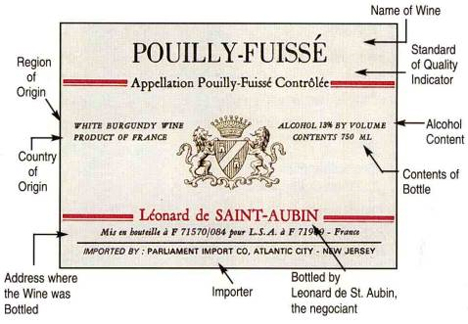How to Read Wine Labels
Although many of us enjoy wine, few of us are expert wine sommeliers. As a result, you may feel overwhelmed when it comes time to choosing wine and reading a wine label. Looking at a label, you may ask yourself, where does this wine come from? Is this wine from a good
vineyard? Was this particular year a good year for this grape?
Similarly, as you take a closer look, you may wonder, how does the vintage of the wine affect the flavor? How does the classification of the wine affect the quality? Learning what these more sophisticated wine terms mean can help you choose the perfect wine for any occasion.
While a wine label may look charming on a bottle, it is also a wonderful source of information for almost everything you want to know about that particular wine. Along with telling you the vineyard of the wine's origin, the label lists the year the wine was made, the type of grape used and any distinguishing awards the wine has won.
Although some wine labels provide more information than others, the mandatory information for wine labels depends on a country's government requirements. Generally, both the country in which the wine is made and the country in which the wine is sold require specific information to be placed on the wine label.
According to U.S. law, every wine label must have contain the following information:
* alcohol content
* brand name
* government warning
* sulfite concentrations (Wines with at least 10 parts per million of sulfites must declare it on their labels.)
* the producer and bottler of the wine, along with contact information
* the type of wine (e.g. dessert wine, aperitif, etc.)
* the volume of fluid within the bottle (This may also be blown into the glass).
Most wine bottles contain two labels, one on the front to attract your attention and one on the back to provide more details about the flavor of the wine. With all of this information, knowing where to start and where to find specific details can be tricky. Read on to learn more
about how to find and interpret the information on wine labels.
Wine Grape Variety
Also known as the varietal, the grape variety refers to the type of grape used to make a particular wine. While it may be obvious, the type of grape a winemaker uses for a particular wine is the foundation of that wine's flavor. Consequently, as you choose and drink wine,
make a note of the grape variety so that you can get an idea of that
grape's general flavor. With a little time, you'll be able to distinguish whether the wine is fruity, full-bodied, nutty or woody. Just by reading the label!
Wine Region
The region tells you the country and usually city in which a particular wine was made. While many countries produce wine, fewer have the ideal conditions to grow quality grapes to make good wine. In fact, did you know that nearly all grapes grown in the world only grow in regions between the 30th and 50th latitude in the both the northern and southern hemisphere?
Wine and Soil
Terroir is the French word that literally translates to "soil." Often, the word terroir is used in the phrase gout de terroir to refer to the "taste of the soil." While clearly you don't taste soil when you drink wine (well, at least, you shouldn't!), the quality and type of soil in which grapes grow affects the taste of the grape and, therefore, the resulting wine.
Clay-like, sandy and gravelly are all ways in which soil quality is described. Keep in mind that none of these terms is meant to distinguish whether a wine is "good" or "bad."
In more general terms, the terroir refers to the overall climate in which grapes are grown. Some of the factors encompassed in the term terroir include:
* altitude
* humidity
* sun exposure
* water drainage.
Some countries, including the U.S., use the term "microclimate"interchangeably with terroir.
Wine Vintage
The vintage of a wine refers to the year in which the grapes for a particular wine were harvested. While some mistakenly think that the vintage is the year that a wine was bottled, a winemaker may age wine in vats for a few seasons before bottling it. As a result, wine made
from grapes a few years ago may not be bottled until today. However, this doesn't mean that the wine bottled today was made from grapes of this year.
Knowing a particular vintage can give you a clue to the quality of the wine. Because of poor weather conditions, some years have poor or bad grape harvests. As a result, vintages of those years are likely to be poorer quality wines than vintages of years that had good grape
harvests. When reading a label and choosing wine, opt for vintages known to have good harvests.
Wine Classification
The classification refers to the type of wine or when it is consumed.
Sommeliers have five classifications for wine:
* aperitiv or aperitif wines: herby or spiced wines served before meals
* dessert wines: sweet wines, usually fortified, to be consumed with dessert
* pop wines: sweeter (generally fruity), cheaper wines
* sparkling wines: wine containing carbon dioxide to make it bubbly
* table wines: cheaper, lower in quality.
While the types of wine are fixed, the way in which they are categorized isn't. Different wine experts classify wine based on any one of the following factors:
* by quality
* by taste
* by vinification methods (how the wine is made)
* by vintage.

